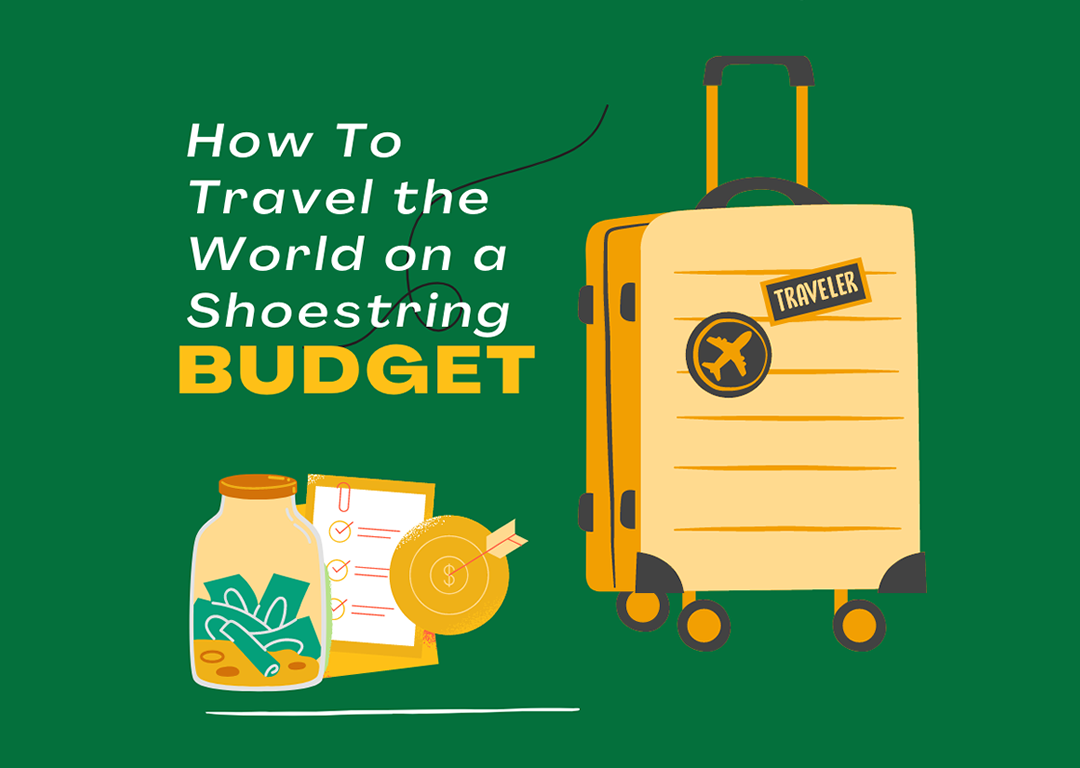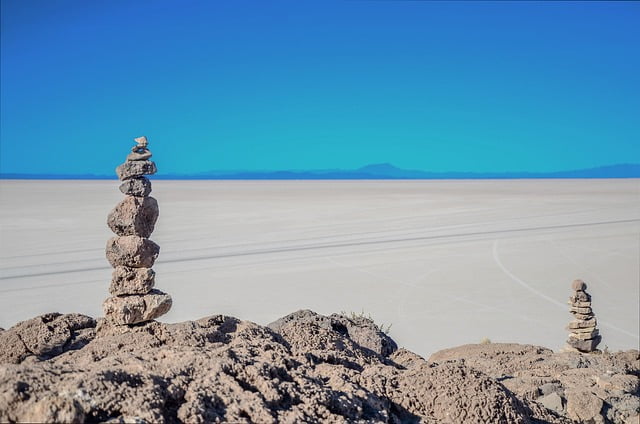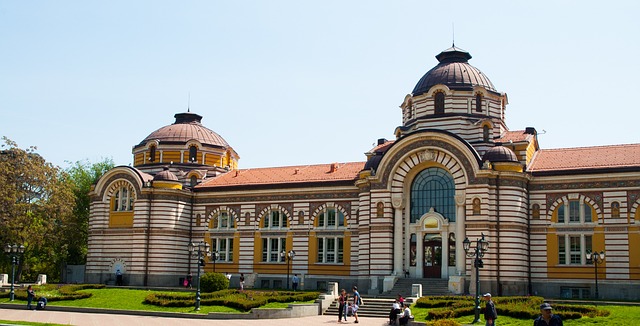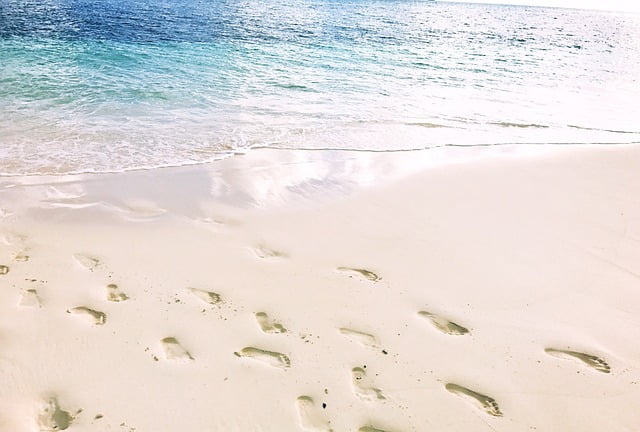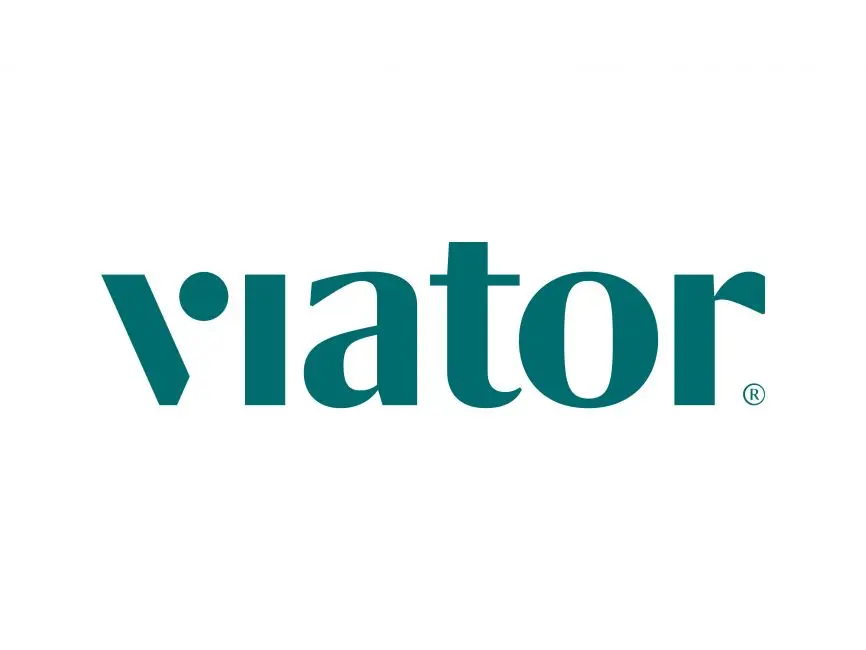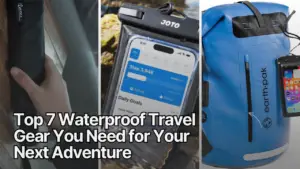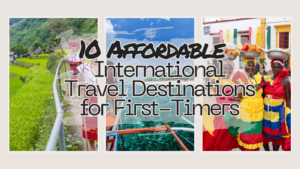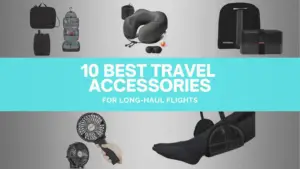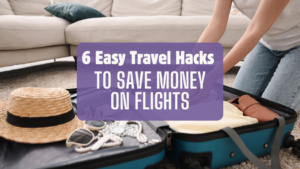Discover tips and tricks for globe-trotting on a shoestring budget this year. Let’s unlock the secrets to affordable world travel and make your wanderlust dreams come true!
Traveling the world on a shoestring budget isn’t about deprivation. It’s about self-discovery – how far you’re willing to go. It’s also an opportunity to enhance your resourcefulness, creativity, and resilience. Not to mention the personal growth from learning all that. 
With little planning and a lot of wanderlust, turning your travel dreams into reality is possible. The greatest riches on the road aren’t measured in dollars, but in experiences and memories. Remember, many successful individuals have started on shoestring budgets, proving that it’s possible to achieve great things with what little you have.
Traveling on a budget doesn’t mean sacrificing the quality and richness of your experience. With a willingness to embrace a different travel style, you can travel the world without draining your wallet. Are you ready?
Key Takeaways:
- Plan your trip. A detailed plan can help you avoid unexpected expenses. Knowing how long you’ll stay in each destination and the route of your adventure can save you money on last-minute flights and accommodations.
- Knowing when to visit your intended destination can significantly reduce costs. Off season travel means lower prices, lesser crowds, and more time to explore.
- Pack Light. Less baggage means lower transportation costs and greater flexibility. Stick to the essentials and embrace a minimalist approach.
- And because you’re on a shoestring budget, opt for the cheaper accommodation, transportation, and dining options.
- Booking flights and accommodations well in advance, especially return flights, can help you secure lower prices and avoid last-minute expensive options.
- Travel Slow. Rushing from place to place will burn a hole in your budget and leave you exhausted. Savor each new destination, and allow time for unexpected adventures.
- Be flexible. Be open to the unplanned, and embrace the unexpected. Some of the best travel memories are made beyond the guidebook pages.
Affordable Locations You Can Explore on a Shoestring Budget
Part of the planning is doing research, so do your homework. Western Europe, South America, Eastern Europe, Southeast Asia, and many countries in Central America are budget-travel paradises. Consider the cost of transportation, accommodation, and activities when choosing your destinations.
Seville, Spain
Seville is located in the southern part of Spain. Known for its rich history, vibrant culture, and distinctive architecture, Seville is considered one of the more affordable destinations in western Europe.
Barrio Santa Cruz is a charming maze of narrow streets in the heart of Seville’s old town. It offers stunning architecture, hidden plazas, and a glimpse into local life. You can wander through it for free and stumble upon unexpected delights.
The largest Gothic cathedral in the world, Seville Cathedral boasts majestic architecture. Its awe-inspiring stained glass windows and breathtaking views can be seen from the Giralda tower, which you can climb for a small fee. Entrance to the main area is free, discounts for students and seniors are available.
Plaza de España is a grand plaza with ornate buildings, canals, and bridges. You can walk around for free, enjoy the atmosphere, and even rent a boat for a budget-friendly sightseeing tour.
Seville is a paradise for tapas lovers. Those who travel on a budget can indulge in delicious small plates and local wines at affordable bars and restaurants, which are often clustered in specific areas like Alameda de Hercules or Triana.
Seville offers affordable hostels, guesthouses, and hotels. Book accommodation in advance to get discounts and secure better deals.
It has an efficient and relatively inexpensive public transportation system. Buses and trams don’t cost as much money, they make it easy to explore the city.
Matera, Italy
Matera is a city and the capital of Matera Province in Basilicata, Southern Italy. It’s known for its unique architecture and historical significance. The city’s unique architecture and rich cultural, culinary, and historical heritage make it a fascinating destination for visitors.
Matera’s sassi districts are ancient cave dwellings carved into the mountainside. These dwellings, some of which are believed to be among the first human settlements in Italy, are now a UNESCO World Heritage Site.
The 13-century Duomo is Matera’s main cathedral. It’s a beautiful example of Romanesque architecture. The interior of is decorated with frescoes and sculptures.
Casa Noha is a traditional cave dwelling that’s been restored to its original condition. It’s now a museum that offers visitors a glimpse into how people lived in the Sassi.
Parco della Murgia Materana is a large park located on the outskirts of Matera. It offers stunning views of the city and the surrounding countryside, and is home to numerous hiking and biking trails.
Matera offers free attractions and free walking tours and activities where you can learn about its history, culture, and hidden gems from a local guide.
Or you can buy the Matera city tourism card for discounted entry to museums and attractions, free public transportation, and other benefits.
Wandering through the labyrinthine alleys, hidden churches, and cave dwellings of the Sassi is a mesmerizing experience.
Matera is home to over 150 rock-hewn churches scattered throughout the Sassi. Some, like the Chiesa di Santa Lucia alle Malve and the Chiesa di San Pietro Barisano, are free to enter and offer stunning frescoes and historical insights.
You can hike in the scenic Murgia National Park, located just outside the city, enjoy breathtaking views of the Gravina ravine and surrounding countryside, and pack a picnic amidst nature.
Several cheap hostels are located within the Sassi, allowing those who travel the world on a budget to experience the heart of the city without spending more money.
You can consider sharing an apartment or room with other travelers through Airbnb for an affordable and authentic experience.
The Mercato Cittadino di Via XX Settembre and the Mercato del Pane are local markets that sell fresh produce, local cheeses, and other specialties at reasonable prices, so you can eat local food or cook your own meals to save money.
Asuncion, Paraguay
Nestled along the serene banks of the Paraguay River, Asuncion, the vibrant capital of Paraguay, invites you to discover a city where colonial charm intertwines with modern vibrancy.
Asuncion’s charm is yet to be discovered. It’s still one of the underrated destinations in South America. Less frequented by tourists, which translates to less competition for services and potentially lower prices for tours and souvenirs.
Asuncion’s relaxed and laid-back atmosphere allows you to slow down and appreciate the simple things without pressure to spend on expensive activities.
Paraguay’s currency (PYG) generally enjoys a favorable exchange rate against major currencies like USD and EUR. This means your travel budget stretches further when spending here.
Centro Histórico de la Ciudad, Asuncion’s historic center, is lined with colorful buildings, cobblestone streets, and charming plazas.
Palacio de los López is a magnificent presidential palace adorned with intricate architecture. It showcases Paraguay’s political history.
The 17-century Museo Casa Blanca was a colonial mansion, now a museum filled with period furniture and artifacts, reflecting Asuncion’s rich past.
The 16th century Iglesia La Encarnación is the city’s oldest church known for its baroque facade and serene atmosphere.
Reserva Natural Cerro Lambaré is a natural reserve known for its diverse flora and fauna. Visitors can hike or climb to the top of this hill for breathtaking city views. The climb is considerably easy, and takes approx 43 minutes to complete.
Lago Ypacaraí is a scenic lake where you can relax on the shores, swim, ride a boat, or enjoy a picnic to escape from the noise of the city.
Paseo Carios is a bustling market that offers fresh produce, street food, and traditional crafts.
Many attractions in Asuncion are free or have minimal entry fees. Its public transportation offers a cheap way to get around. Its accommodations are significantly cheaper compared to other South American capitals.
There’s street food. Local delicacies like asado, empanadas, and other hearty meals are served in small restaurants and local markets at a fraction of the cost in other cities. Sit-down meals at mid-range restaurants cost 30,000.00Gs or $4.12 on average per person.
Uyuni Salt Flat, Bolivia
The Uyuni Salt Flat (aka Salar de Uyuni) is located in Bolivia. It’s the world’s largest salt flat, covering over 4,050 square miles. The unique landscape was formed by the evaporation of prehistoric lakes, leaving behind a vast expanse of salt with unique polygonal patterns.
The salt flat is beautifully surreal when a thin layer of water covers the surface. Its otherworldly (mirror effects and geometric patterns) and breathtaking landscapes draw tourists worldwide.
The nearby town of Uyuni serves as a popular jump-off point for salt flat tours. Salar de Uyuni is also a significant site for salt and lithium extraction, with vast reserves of untapped lithium lying beneath the salt flat.
Often used as a backdrop for films and photo ops, Uyuni is also home to several hostels, guesthouses, and restaurants, making it a convenient base for exploring the region.
You can take a jeep tour and visit Incahuasi Island, a cactus-covered island in the middle of the salt flat. Take photos or go stargazing.
A 3-day shared tour in Uyuni costs around $159 per person. Or 1,098.97 bs (bolivianos), the official currency of Bolivia. Tours usually include meals and cheap accommodation, so you only need to pay extra for entrance fees, border tax, toilet, drinking water, and hot showers.
There are unique hotels built entirely from salt blocks, where you can camp for a distinctive, novelty experience. They’re typically located on the outskirts of Uyuni and offer a blend of comfort and affordability – making Uyuni an attractive option for tourists who travel on a budget.
Sofia, Bulgaria
Nestled at the foot of the Vitosha mountain, Sofia is the captivating capital of Bulgaria. The dynamic fusion of ancient history and dynamic urban life is enchanting. It offers a blend of Ottoman mosques, Red Army monuments, and Roman ruins, making it a historically rich destination. It’s surrounded by sprawling parkland and is a gateway to the popular ski mountain, Vitosha, which is about an hour’s drive.
The city is known for its mineral springs and its humid continental climate. Sofia’s history as an ancient city is still visible. It’s home to many of Bulgaria’s finest museums, galleries, restaurants, and clubs.
Nature lovers can hike through the pine forests of Vitosha National Park, climb snow-capped peaks in winter, or take a thrilling cable car ride for breathtaking panoramic views.
St. Alexander Nevski Cathedral is a magnificent Neo-Byzantine cathedral that dominates the city skyline with its golden domes and intricate mosaics.
Boyana Church is a Unesco world heritage site known for its stunning frescoes, which are considered masterpieces of early Eastern Orthodox art.
The National Historical Museum houses historical artifacts and conducts archaeological exhibits, and interactive displays.
Vitosha Boulevard is a vibrant pedestrian street lined with shops, cafes, and street performers.
The National Museum of Earth and Minerals houses some of Bulgaria’s rarest collection of crystals and minerals; showcases the fascinating world of geology; and Bulgaria’s rich mineral resources.
Modern Sofia is bustling with wide boulevards lined with grand Neoclassical buildings and contemporary skyscrapers. Trendy cafes and lively bars spill onto cobbled streets, while bustling markets are filled with local delicacies and handcrafted souvenirs.
Brasov, Romania
Brasov beckons with its medieval charm, cobblestone streets, and the dramatic silhouette of the Black Church. It’s the 7th largest city in Romania. But it’s often referred to as a town due to its historical and architectural characteristics, such as its well-preserved medieval old town.
The Old Town of Brasov is the historic, architectural, and culinary heart of the city. It features well-preserved medieval landmarks and charming cobbled streets.
The Black Church (Biserica Neagră) in Brasov is the largest Gothic church in Romania. It houses a 185-year-old, 4000-pipe organ known for its ornate funerary stones; numerous gargoyles; the largest collection of Anatolian rugs in Europe, etc.
Brasov is a compact city that can be easily explored on foot, eliminating the need for expensive public transport.
Taking advantage of a free walking tour around the city will give you insights into its history and culture. Taking a stroll instead of riding is also a way to save money.
Rope Street (Strada Sforii) in Brasov, Romania, is the narrowest cobbled street in the eastern part of Europe, and the 3rd narrowest in the continent. It has an average width of only 44-53 inches. The street is a charming passageway with colorful houses and offers a unique experience to visitors.
The 13-century Rasnov Citadel is a fortress built on a rocky hill. It offers breathtaking views and a glimpse into the region’s defensive past.
Explore the stalls of Piata Sfatului that sell traditional crafts, handmade souvenirs, and local delicacies.
Take the cable car up Mount Tâmpa for panoramic views of the surrounding mountains. Hike or bike through the Tâmpa Natural Park, which is a haven for outdoor enthusiasts.
Bran Castle is often associated with Dracula. But this iconic castle perched on a hilltop offers a glimpse into Romania’s medieval life with its impressive architecture and captivating history.
Brasov’s nightlife buzzes with lively pubs, hidden gems that play jazz, karaoke, and even medieval tavern vibes.
Brasov offers various accommodation options for people who travel on a budget. Charming guesthouses, hostels, hotel stays – all are cheaper than most countries in south eastern Europe.
Indulge in local food like sarmale (stuffed cabbage leaves) or mici (grilled meatballs) at local restaurants where you can enjoy traditional dishes at lower prices than in most major cities. Or opt for budget-friendly guest houses or apartments with kitchen facilities to prepare some of your own meals.
Siargao, Philippines
Siargao is a beautiful, teardrop-shaped island located in the northeastern part of Mindanao, the Philippines. Known as the country’s surfing capital, Siargao is more than just a surfer’s paradise. It’s also home to stunning beaches, mangrove forests, and natural rock pools.
The fastest way to get to Siargao is to fly into Sayak Airport (aka Siargao Island International Airport). You can also take a ferry to Siargao from Cebu or Surigao City.
You can take a combination of buses, ferries, and vans from Bohol or Palawan to get to Siargao. It’s a challenging but a cheaper option if you’re on a tight budget.
- Cloud 9 is a right-hand reef break located in General Luna, Siargao. It’s about a 45-minute drive from Sayak Airport, and is considered one of the best surfing spots in the Philippines, and even around the world.
- Cloud 9 is famous for its thick, hollow tubes and fast-barreling right-hand waves that break over a reef, mostly suitable for advanced surfers. Described as a “death ride,” the wave crashes onto shallow razor-sharp corals. Cloud 9 is also the venue for the Siargao Cup, an international surfing competition held every September.
The best time to visit Siargao is during the peak surf season (September to November). The island experiences the famous Cloud 9 wave at its best, attracting surfers from around the world to enjoy the exhilarating waves and vibrant surfing culture.
- Sugba Lagoon is a hidden gem surrounded by mangrove forests. It can be reached by a 45m to an hour boat ride from Gen. Luna via Del Carmen. The lagoon isn’t overly crowded. You can take photos, dive, swim, or stand-up paddleboard.
- The Magpupungko Rock Pools in Siargao are natural rock pools that are only accessible during low tide when the receding water reveals their beauty. The turquoise waters nestled among dramatic volcanic rock formations, some with natural pools up to 3 meters deep, are perfect for swimming, cliff jumping, and exploring.
The Philippines is generally comparable to most countries in the Southeast Asian region in terms of affordability. Siargao isn’t the cheapest island in the country. But there are numerous options for those who travel on a budget, who are flexible and prioritize experiences over luxury.
Staying in General Luna, the main tourist hub, puts you close to many restaurants, shops, and activities. It’s a cost effective way to save money, minimizing the need for public transport. A habal-habal is a motorbike with a platform on the back for passengers.
Siargao isn’t just for surfing enthusiasts. There are alternative activities for non-surfers, like kayaking, island hopping, or exploring waterfalls.
The island caters to all budgets – from backpacker hostels, budget hotels ($30-50/night), homestays and hotel stays to luxury resorts. A light sleeper on a budget can find a night’s accommodation for only $55 or lower.
Siargao offers everything from grilled skewers and fresh lumpia to native rice cakes and halo-halo. These snacks are a great way to save money and experience local flavors.
Try delicious Filipino cuisine at local markets and carinderias (eateries). You’ll find budget meals for $3-5), and they’re often more authentic than tourist fare.
Phnom Penh, Cambodia
Located in southeast Asia, Cambodia’s bustling capital city Phnom Penh is surrounded by the Kandal province and lies at the junction of the Basăk Sab and Mekong river systems.
It’s a city that blends historical sites with modern development, offering visitors, especially those who travel on a budget, a unique glimpse into Khmer culture without spending money on expensive tours and activities.
The Royal Palace opens at 2:00 PM for afternoon hours, while the National Museum opens at 8:00 AM and closes at 5:00 PM. Last admission tickets are sold at 4:30 PM. Consider buying combination tickets for multiple sites to save more money.
Admission fee for the Royal Palace costs $10 for foreigners. The National Museum has an entrance fee of $10 for foreigners aged 18 years old and up, and $5 for foreigners aged 10 to 17 years old. Children and school groups are free.
The Royal Palace serves as the official residence of the royal family. Known for its intricate architecture, the complex consists of:
The Throne Hall is characterized by a 59-meter-high tower. It was built in 1919 and is still in use today as a venue for coronations, religious ceremonies, and other royal functions.
The Silver Pagoda (aka Temple of the Emerald Buddha) is a Buddhist temple located within the grounds of the Royal Palace. Its floor is made up of 5,329 silver tiles, each weighing about 1 kilo. These tiles were added in 1962 by King Sihanouk, giving the pagoda its namesake.
It houses, among other treasures, the 17th-century Emerald Buddha, a statue made of Baccarat crystal; a 90-kg gold Buddha statue adorned with over 9,000 diamonds; and a collection of gifts presented to Cambodian royalty by foreign dignitaries.
The original Chan Chaya was built in 1885 during the reign of King Norodom. The current one was constructed during the reign of King Sisowath in 1913 to replace the earlier one. Both pavilions feature an iron structure and a large balcony overlooking the palace grounds and Sothearos Boulevard.
Situated next to the Royal Palace, the National Museum is home to the world’s finest collection of Khmer art and sculptures, textile, and ceramics spanning over a thousand years.
A free walking tour around the Central Market can take you to its labyrinthine alleys lined with hundreds of stalls that sell clothing, silk scarves, jewelry, handicrafts, silverware, local spices, and other Cambodian goods.
The Tuol Sleng Genocide Museum chronicles the Cambodian genocide. It was a school building used as a security prison by the Khmer Rouge regime from 1975 until its fall in 1979. It was one of the torture and execution centers established by the Khmer Rouge, where an estimated 20,000 were imprisoned.
Opting for cheaper yet comfortable lodgings is a practical way to save money. Cambodia offers low-cost accommodations and food. A satisfying meal in Phnom Penh can cost as little as $2-3 USD.
Tuk-tuks, the iconic open-air taxis, offer cheaper rides within the city. Short trips start around $1-2. Public buses are even cheaper, but not readily available, especially in less touristy areas.
Phnom Penh’s street food scene is a culinary adventure with bustling markets offering savory noodles to delectable skewers. As the sun sets, the city transforms with a vibrant nightlife. Its lively bars along the Mekong River and energetic nightclubs pulsate with music.
Friendly bargaining in markets and with tuk-tuk drivers allows you to get the best deals and stretch your budget even further, and have a fun cultural interaction with locals.
Cambodia’s low cost of living is reflected in the affordability of basic necessities like groceries and utilities. This translates to lower expenses for visitors on a tight travel budget.
Depending on the currency in your home country, you might find the Cambodian Riel to be very favorable, allowing you to save money and extend your daily budget.
Guatemala
Guatemala is a beautiful country in Central America with a diverse culture and history. Guatemala City, the capital city, offers a mix of commerce, culture, and historical landmarks, including the National Palace and the Metropolitan Cathedral.
Guatemala is home to many active and inactive volcanoes, including the Pacaya volcano, which is constantly spewing smoke and ash.
Tajumulco is Central America’s highest peak. This stratovolcano in San Marcos, western Guatemala, South America, is a popular destination for hiking and climbing. Hiking the summit, even with a tour guide, is challenging. But the views from the top are incredible.
Guatemala offers free walking tours for its stunning attractions, like volcanoes, waterfalls, and natural parks. This allows people who travel on a budget to experience the beauty of the country without spending a fortune.
Guatemala was the heart of the Mayan civilization. Many impressive ruins are scattered throughout the country, including Tikal – an ancient Mayan city hidden in the jungles of the Petén Basin.
Tikal National Park is a UNESCO World Heritage Site and a fascinating archaeological wonder. It features the remains of what were once awe-inspiring temples, public squares, and pyramids.
You can enjoy a sit-down meal in between tours while exploring the beauty of the place for a very reasonable price.
Chicken buses, the country’s iconic shared buses, are known for their colorful decorations and sometimes chaotic nature, which can be part of the experience. They’re a cheaper way to travel between towns and cities. Taxis and shuttles are also readily available, offering convenient transportation options.
Antigua is a colonial city and a UNESCO World Heritage Site known for its well-preserved Spanish colonial architecture, cobbled streets, and vibrant cultural scene. The city is framed by the stunning backdrop of the Agua Volcano. Antigua is beautiful, but it can be quite touristy.
Lake Atitlán is a stunning lake on a crater in the southwest highlands of Guatemala. The lake is surrounded by volcanoes and Mayan villages, and is a popular spot for swimming, kayaking, etc.
Guatemala’s rainforests are home to a huge variety of plants and animals. They’re also an important source of water for the country.
Guatemala is the world’s leading producer of jade, one of the world’s leading producers of coffee, and Guatemalan textiles, which are known for their vibrant colors and intricate designs.
If you’re from any country with a stronger currency like the $ or €, your money could go a long way in Guatemala. This allows you to experience more without breaking the bank.
Guatemala’s budget-friendly accommodations suit various budgets. there are many hostels, family-run guesthouses, mid-range hotels and vacation rentals – you’ll always find something cheaper that fits your needs and budget.
Lima, Peru
Lima is a vibrant metropolis known for its rich history. Peru’s capital is a mix of modern and colonial architecture. It’s a culinary hotspot that offers traditional and contemporary Peruvian cuisine.
Lima is still considered more expensive than other cities in the region like Cusco or Arequipa. However, there are many ways to enjoy Lima on a budget, such as opting for lesser-known experiences, staying in budget accommodations, and taking advantage of cheaper transportation options.
Exploring the historic center and strolling along the Malecón (waterfront boardwalk) won’t cost a dime. Museums have minimal entry fees, if not free. You can also find cheap or free walking tours of the city.
Each of Lima’s neighborhoods has its own unique character. Miraflores is known for its cliffs and ocean views, Barranco is known for its bohemian atmosphere, and the historic center is home to many colonial buildings and museums.
Plaza de Armas de Lima is the city’s main public space and sits within the historic center, declared a UNESCO World Heritage Site in 1991. It’s surrounded by important historical buildings including the Archbishop’s Palace of Lima. The square boasts a 17th-century bronze fountain in its center.
The Cathedral of Lima is the oldest cathedral in South America and is a beautiful example of colonial architecture.
The San Francisco Monastery is a large and impressive monastery that’s home to a number of important religious artifacts.
The Larco Museum is a private museum that houses one of Peru’s finest historical collections devoted to the country’s pre-Columbian heritage, including gold and jewelry, ceramics, sculptures, and other artifacts from the ancient world.
The Museum of the Nation is the national museum of Peru and houses a large collection of artifacts from the country’s history.
Lima has cheaper guesthouses, hostels, and Airbnbs, which is greatly appreciated by budget-conscious travelers around the world.
Peruvian cuisine is one of the most diverse and delicious in the world. And Lima is a great place to try these.
- Ceviche (raw fish marinated or cured in citrus juices), while traditionally made with raw fish, has some variations that involve slightly cooked seafood for those less comfortable with raw options.
- Lomo saltado (stir-fried beef with veggies) often includes tomatoes, onions, aji amarillo peppers, and sometimes vinegar besides the vegetables. It’s typically served with rice and french fries.
- Aji de gallina (shredded chicken in spicy pepper sauce). The sauce is usually made with aji amarillo peppers, milk, cheese, and walnuts, creating a creamy and slightly spicy flavor.
Common mistakes to avoid when traveling on a budget
Not having a travel plan and budget. Traveling on a shoestring budget requires planning and a set budget. Failing to do so can result in overspending and financial stress during the trip.
Not researching the cost of living at your destination can lead to unexpected expenses and may exceed your budget.
Not sticking to your set budget is like allowing yourself to be swept up in the moment and go beyond your budget, especially when it comes to shopping and food, which can quickly add up.
Not figuring out your local transportation options can result in unnecessary expenses on taxis or other expensive means of transportation.
Overpacking can lead to additional baggage fees and unnecessary expenses.
Not buying travel insurance can leave you vulnerable to unexpected expenses, such as trip cancellations, medical emergencies, or lost baggage.
Not planning in advance, like where to go, where to stay, and activities to engage in can result in higher costs and less enjoyable experiences
Not staying informed about special travel deals and discounts can lead to missing out on potential savings.
Opting for expensive restaurants or cafes instead of local options can significantly increase your food expenses.
Not getting a local SIM card and relying on international roaming or expensive data plans can result in high phone bills.
Basic tips to earn money and boost your personal finance while traveling around the world
- If you have a property back home, consider renting it out to generate passive income while you travel.
- If you have some savings, consider low-risk investments. Consult with a financial advisor to explore options on how to earn money while you work abroad.
- Look for flexible job opportunities in your field. This can include writing, teaching or tutoring, graphic design, programming, or other services that can be done remotely.
- Be a tour guide. Lead tours for tourists in a foreign city or region. This requires knowledge of the local area, good communication skills, and often needs specific licenses or permits.
- Help out on a farm in exchange for accommodation and meals. This requires knowledge, an interest in agriculture, and a willingness to work outdoors.
- Connect with hosts who offer accommodation and meals in exchange for work on various projects (e.g., gardening, home renovation, pet sitting, volunteering, etc.).
- Engaging in house-sitting allows travelers to stay in a home for free while taking care of the owner’s property. It’s a practical way to enjoy free accommodation.
- Note: Visa requirements and regulations vary by country and the job type you’re applying for. Always research these thoroughly before committing to any work abroad.
Advantages of house-sitting
- House-sitting aligns with the shoestring budget approach, emphasizing cost-effective alternatives to paid accommodation options.
- House-sitting websites connect homeowners to travelers who are willing to house-sit while they’re away. These websites facilitate the house-sitting transactions.
- Some popular house-sitting websites include TrustedHousesitters or HousePass. These allow you to browse listings for house-sits in different locations around the world.
- Find the best house-sitting websites. This increases your chances of finding the most suitable and free accommodation while you house-sit – with free WiFi, if lucky.
- Access to free WiFi is necessary for people who travel on a budget. It enables them to stay connected without paying additional data charges.
- Finding free accommodation through house-sitting lets you save money for other expenses, such as food, transportation, and activities.
Tips for Making Your Money Last Longer While Traveling
Choose an accommodation that has a kitchen so you can cook your own meals.
Share the fun with fellow travelers. Organize picnics in parks or potlucks in hostels to enjoy delicious food.
Hitchhiking can be a way to cut transportation costs in regions where it’s considered safe and culturally acceptable.
For the ultimate outdoor experience, consider camping or couchsurfing. Pitch a tent under the stars or crash on a local’s couch for a truly immersive experience.
Exploring opportunities for earning or redeeming airline miles, and points, or using travel rewards programs can lead to discounted or even free flights.
A travel app helps find the best deals, compare prices, and access valuable information to keep track of your travel spending.
You’d get alerts from your travel app for airline updates, and sudden price drops in flights and accommodations. This allows you to take advantage of potential cost reductions, ensuring maximum value for money.
Rail passes, free flights, and city tourism cards
- Rail passes are often available through national railway websites or dedicated rail pass websites. In Europe, you can explore options on Eurail or Interrail.
- Look for airline promotions, loyalty programs, and fee-free credit card sign-up bonuses. Skyscanner, Google Flights, or airline newsletters can notify you of special flight deals.
- Frequent use of certain credit cards lets you accumulate airline miles through loyalty programs or credit card rewards.
- City tourism cards are available through the official tourism websites of the destination you intend to visit. Or at their tourist information centers.
- Buy a card that provides access to public transportation, discounted or free entry to attractions, and other perks.
Save up on foreign ATM fees
Finding low-fee ATMs means saving money when withdrawing cash in a foreign country. It ensures you don’t lose a significant portion of your good budget to transaction fees.
Using fee-free cards (credit or debit cards) abroad helps avoid additional charges for currency conversion or international transactions. This is crucial for budget-conscious travelers to keep costs down, especially on their first trip.
Being aware of ATM fees is important, as some banks charge higher ATM fees for international withdrawals. Saving money by using fee-free options while traveling aligns with the goal of a shoestring budget.
Conclusion:
Traveling the world on a budget requires a merry mix of resourcefulness, planning, and flexibility. Securing fee-free arrangements, taking advantage of free flights and city tourism cards – each of these contributes to a thrifty adventure.
Managing your finances, exploring many countries, preparing your food, and opting for modest hostels are big steps toward your travel dreams. It’s about making well-thought-out choices, tapping into remote work opportunities, and embracing the richness of diverse cultures without spending too much.
With a brave and adventurous spirit and an eye for keenly-priced options, the world becomes not just your next trip. It’s an ocean of overflowing experiences accessible only to the daring and savvy budget travelers.
FAQs:
At what age should you start traveling the world?
There’s no single “best” age to start traveling the world. While teenagers (ages 13-19) often requires parental permission and supervision. Group travel or organized programs might be more feasible.
Young adults (20-30) have the flexibility with time and potentially fewer financial constraints. This is a popular age for gap years, backpacking and volunteer programs.
Mid-life (30-50) have more financial stability and potentially established careers, allowing for longer or more luxurious travel experiences.
Ultimately, the best age to travel is when it feels right for you!
What’s the difference between hostels and homestays?
Hostels are shared rooms, with a lively, social atmosphere for meeting new people. It’s the most affordable option, but with limited privacy, and access to only the basic amenities.
Homestays, on the other hand, are private rooms in a rented home, so there’s more privacy. It often includes meals for a taste of home cooking. May have more amenities but less social interaction with other travelers, and a bit more expensive.
Some hostels offer private rooms in some instances. Homestays may or may not include meals depending on the arrangement. Also, social interaction in homestays varies depending on the host family.
Can you travel the world with little money?
Traveling the world with little money requires flexibility, resourcefulness, and a willingness to step outside your comfort zone, but it’s achievable. Choose cheap destinations, travel slowly, learn to adapt to new things – like staying in hostels, cooking your food, taking walking tours, etc. It’s challenging. But the unique experiences you’ll learn from it is more than rewarding.
Which airline offers the most comfortable economy flight experience?
Delta Air Lines offers a comfortable economy experience with a competitive seat pitch and size, along with seatback screens on most planes.
Qatar Airways is consistently praised for comfortable seats, attentive service, and in-flight entertainment.
Singapore Airlines is known for excellent service, comfortable seats, and delicious food options.

